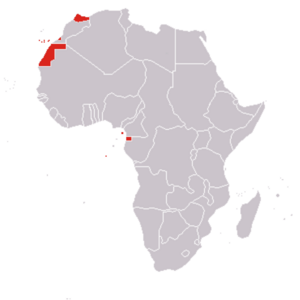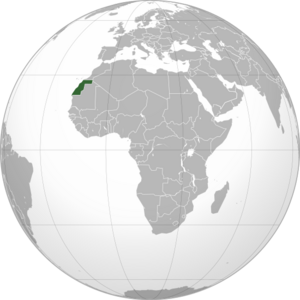Spanish Africa facts for kids
Spanish Africa refers to different parts of Africa that have had a special connection with Spain. This includes places that were once Spanish colonies and some areas that are still part of Spain today. Spain's history in Africa goes back many centuries, involving trade, exploration, and sometimes control over territories.
Contents
What is Spanish Africa?
Spanish Africa can mean a few things:
- Areas in North Africa that are still part of Spain.
- Lands in West Africa that Spain used to control.
- A country in Central Africa that was once a Spanish colony.
Let's explore these different parts of Spanish Africa.
Spanish North Africa Today
Today, Spain still has several territories in North Africa. These areas are very important to Spain.
Ceuta and Melilla
Ceuta and Melilla are two Spanish cities located on the northern coast of Africa. They are right next to Morocco. These cities are not just small towns; they are like special parts of Spain, with their own governments. They have been Spanish for a very long time, with Ceuta becoming Spanish in 1668 and Melilla in 1497. They are important for trade and as borders between Europe and Africa.
Plazas de Soberanía
These are small Spanish territories scattered along the Mediterranean coast, bordering Morocco. The name "Plazas de Soberanía" means "Places of Sovereignty." They include small islands and peninsulas. They are also part of Spain and are mostly used for military purposes.
Canary Islands
The Canary Islands are a group of Spanish islands located off the northwest coast of Africa. Even though they are geographically closer to Africa, they are a full part of Spain. They are famous for their beautiful beaches and volcanoes, making them a popular place for tourists from all over the world. The Canary Islands have been part of Spain since the 15th century.
Past Spanish Territories in Africa
Spain also had many colonies and protectorates in Africa in the past. These areas gained their independence in the 20th century.
Spanish Protectorate of Morocco
From 1912 to 1956, a part of Morocco was under Spanish control. This was called the Spanish Protectorate of Morocco. A protectorate means that Spain helped govern the area, but it was still officially part of Morocco. This region was mostly in the northern part of Morocco. After 1956, this area became part of independent Morocco.
Spanish West Africa
Spanish West Africa was a group of Spanish territories in West Africa from 1946 to 1958.
Spanish Sahara
Spanish Sahara was a large territory that Spain controlled from 1884 to 1976. It included two main parts: Río de Oro and Saguia el-Hamra. This area is now known as Western Sahara. After Spain left in 1976, there was a conflict over who should control the land, and much of it is now managed by Morocco.
Cape Juby and Ifni
- Cape Juby was a coastal area in southern Morocco that was part of the Spanish protectorate until 1958. It was then returned to Morocco.
- Ifni was another coastal area in southern Morocco. It was part of Spain until 1969, when it also became part of Morocco. Today, it is known as the Moroccan province of Sidi Ifni.
Spanish Guinea
Spanish Guinea was a Spanish colony in Central Africa from 1926 to 1968. Today, this country is known as Equatorial Guinea. It gained its independence from Spain in 1968.
Annobón and Fernando Pó
- Annobón is a small island that became a Spanish territory in 1778.
- Fernando Pó (now called Bioko) is a larger island that also became Spanish in 1778.
- Río Muni is the mainland part of Equatorial Guinea, which also became Spanish in 1778.
These three areas were combined to form Spanish Guinea.
See also
 In Spanish: África española para niños
In Spanish: África española para niños
- Ceuta and Melilla (disambiguation)
- Canary Islands



